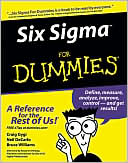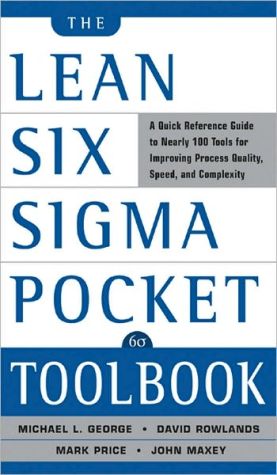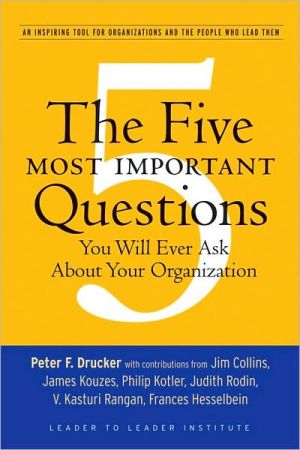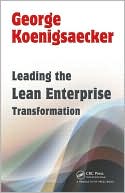Six Sigma For Dummies
Search in google:
With tools and tips for making sense of Six SigmaUse Six Sigma to improve business performance — and reap big profitsMillions of people work in companies that use Six Sigma to achieve quantum leaps in performance — in everything from products and processes to systems and even environments. But for beginners, Six Sigma can seem confusing and mysterious. Relax! Six Sigma For Dummies explains it all — whether you need help implementing the methodology, or just understanding it.Discover how toUnderstand what Six Sigma is and how it worksUtilize the right tools and technologiesSpeak the language of Six SigmaKnow the responsibilities of team membersMaster the statistics skills you'll need
ForewordxvIntroduction1About This Book1Conventions Used in This Book2Foolish Assumptions3How This Book Is Organized3Icons Used in This Book4Where to Go from Here5Part ISix Sigma Basics7Chapter 1Defining Six Sigma9The Managerial Perspective11Radical corporate success12Bridge between science and leadership12Management system orientation13The Technical Perspective16Product, service, and transactional quality17The journey from one to many20Watch out for the wiggle, bump, and jitter22Why six and why sigma? (Putting the pieces together)23Chapter 2Examing the Principles and Language of Six Sigma27It All Begins with One Simple Equation: Y = f(X) + [epsilon]27Determine the Cause29Cause and effect29There is a better way30Beware superstitious delusions (that is, correlation doesn't imply causation)30Variation happens32What is variation?33Where does variation come from?34Getting variation right is everything35Thou Shalt Measure36Mind your Ys and Xs36The answer begins with the data37The bottom line on measurement38The Power of Leverage38The "vital few" versus the "trivial many"39Finding the better way40Chapter 3Pinpointing the Essentials of Six Sigma41The Project Strategy: DMAIC41Domains of Activity43Thinking for breakthrough43Processing for breakthrough44Designing for breakthrough44Managing for breakthrough45The People: Who You Need to Know46In Six Sigma, everyone's a leader46Number-crunching karate: Black Belts and their brethren51Bringing the team together54The Lifecycle of a Six Sigma Initiative55Initialize: Ready ... Aim ...55Deploy: Setting it all in motion56Implement: Forging first successes57Expand: Taking it everywhere58Sustain: The self-healing culture58Part IIUnderstanding and Enacting the Breakthrough Strategy (DMAIC)61Chapter 4Finding the Pain - Defining Projects63The Six Sigma Project64The basics of a project64The problem transformation65Project responsibilities65Your Needs, My Needs, What Are They?66Aligning Six Sigma with strategy67Using a business case writing tool for project identification69Six Sigma project definition71Is it worth doing?75Chapter 5Measuring the Gaps85The 1, 2, 3s of Statistics85Why statistics?86Measurement 10187What does it mean? Measures of variation location88How much variation is there?91The Long and Short of Variation95Short-term variation96Shift happens: Long-term variation99Be all you can be: Entitlement101A Picture's Worth a Thousand Words103Plotting and charting data103Hindsight is 20/20: Behavior charts117Chapter 6Measuring Capability123Specifications: The Voice of the Customer123How close is close enough? Or why specifications?124What are specifications?124Do you do the RUMBA? Creating realistic specifications125Don't push that big red button! What happens when you exceed a specification126Capability: Comparing the Voice of the Customer to the Voice of the Process128Measuring yield128Measuring defect rate133Linking yield and defect rate138Sigma (Z) score138Capability indices144Prescribing a capability improvement plan147Chapter 7Separating the Wheat from the Chaff149Understanding Data Types150Attribute or category data150Continuous or variable data151Avoiding Illusion: Measurement System Capability Analysis152Sources of measurement system variation154Measuring measurements: Measurement system analysis (MSA)156Filling the Funnel161Let the data do the talking162Cast a big net162Mining Data for Insight163Go with what you have: Observational studies163Digging in: Identifying potential sources of variation through graphical analysis165Chapter 8Quantifying the Critical Few169Finding the Best Partner169Viva Las Vegas: The central limit theorem170How sure are you? Confidence intervals171Confidence intervals for means172Confidence intervals for standard deviations176Four out of five recommend: Confidence intervals for proportions178Understanding Relationships180Correlation180Curve fitting183Chapter 9Achieving the Objective195Why Experiment? The Improvement Power of Six Sigma Experiments195What is an experiment, anyway?195The purpose of Six Sigma experiments196Experimenting with words197The end game of Six Sigma experiments197Look Before You Leap: Experimental Considerations198Frankenstein should have planned198Simple, sequential, and systematic is best2002[superscript k] Factorial Experiments202Plan your experiment202Conduct your experiment206Analyze your experiment207You've Only Just Begun - More Topics in Experimentation216Chapter 10Locking in the Gains217The Need for Control Planning217The process management summary219The process control plan219Statistical Process Control221Monitoring the Process: Control Chart Basics222Understanding control limits223Using control charts to keep processes on track226Using control charts to detect patterns, shifts, and drifts227Collecting data for control charts229Control Charts for Continuous Data230Individuals and moving range chart (I - MR)232Averages and ranges chart (X - R chart)234Averages and standard deviation chart (X - S)235Control Charts for Attribute Data235The p chart for attribute data237The u chart for attribute data238Poka-Yoke (Mistake-Proofing)239Part IIIThe Six Sigma Tool and Technology Landscape241Chapter 11Identifying Six Sigma Practitioner Tools243The Practitioner's Toolkit244Process Optimization Tools245The SIPOC246What's critical? Look in the CT Tree248Modeling a process251Simulating a process256Cause-and-effect (C&E) matrix258Dem' fishbones259FMEA: Failure mode effects analysis260KISS and tell: Capability-complexity analysis262Funnel reports264Plans265Statistical Analysis Tools267The basics268A picture's worth a thousand ... dollars268The time machine270Analysis of variance: ANOVA271If the shoe fits271Design of Experiments272How capable is your process?273Regression275Multivariate analysis275Exploratory analysis276Measurement systems analysis276Back to the future278Platforms and Protocols278Software products278Technology architectures280Chapter 12Mastering Six Sigma Manager Tools283The Manager's Toolkit284The gallery285Types of management tools286Through the Looking Glass287Project Management288Eureka!289Pick a winner290Project definition291Project planning and tracking293Just the Facts, Ma'am295Knowledge Management298An Apple for Your Apple299Part IVThe Part of Tens301Chapter 13Ten Best Practices of Six Sigma303Set Stretch Goals303Target Tangible Results304Determine Outcomes304Think Before You Act305Put Your Faith in Data305Minimize Variation306Align Projects with Key Goals306Celebrate Success!306Involve the Owner307Unleash Everyone's Potential307Chapter 14Ten Pitfalls to Avoid309Not Allowing Enough Time309Who's the Leader?309Taking Too Big a Bite310Focusing On Isolated Areas310"But We're Different"310Overtraining311Blindly Believing Your Measurement System311"Remind Me Again, Is It CLs or SLs?"312Exaggerated Opportunity Counts312Not Leveraging Technology312Chapter 15Ten Places to Go for Help313Colleagues313Six Sigma Corporations314Associations and Professional Societies314Conferences and Symposia314Publications315Web Portals316Periodicals316Technology Vendors317Consultants317Six Sigma Trainers318AppendixGlossary319Afterword329Index331








